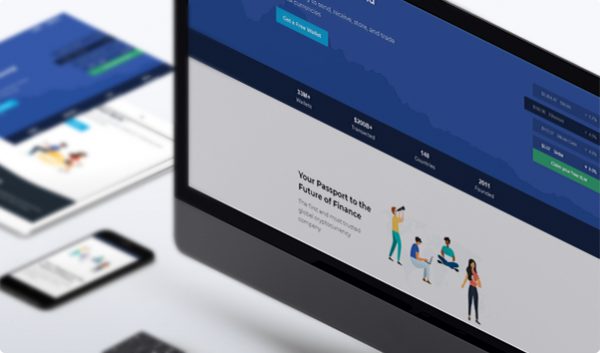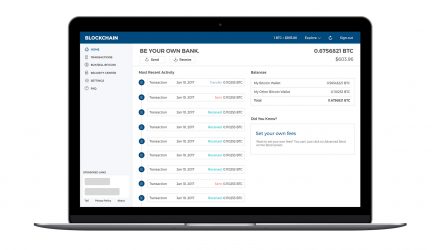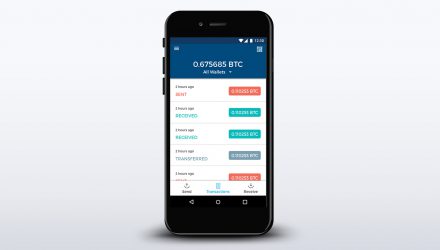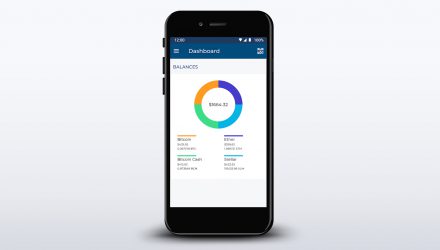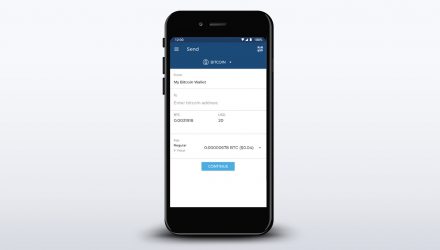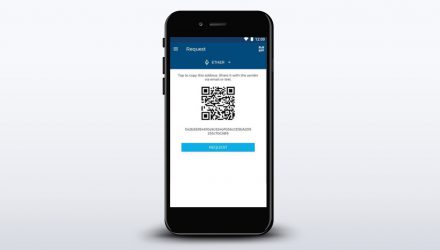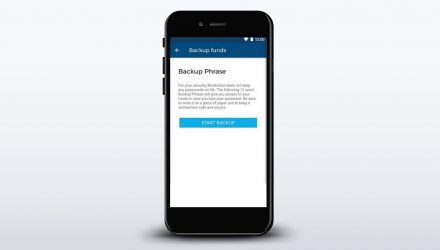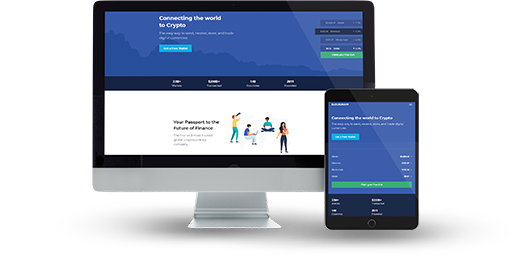
You Can Choose To See Your Balance Reflected In Your Local Currency
4-Digit-Pin or Biometrically Authenticate With Fingerprint Recognition
Blockchain Wallet Is Only Compatible With Bitcoin, Bitcoin Cash, Ether And Stellar
Advanced Security Features, Such As Two-Factor Verification
Hierarchical Deterministic
Software Wallets Tend To Be More Vulnerable To Cyber-Attacks Than Hardware Wallets
Blockchain Wallet Review: Comprehensive Review and Guide
Blockchain is one of the most reputable crypto companies, situated in Luxembourg. Its wallet is available for both web and mobile usage and it’s considered one of the most preferred on the market. Supporting most of the major coins – Bitcoin, Bitcoin Cash, Ethereum and Stellar, in this review of the Blockchain wallet, you will see why it is so popular.
01.Blockchain Wallet Features & Fees
Stepping into the blockchain world, you should completely understand how the public ledger works for the purpose of extracting the best of it for yourself. In a word, miners are confirming transactions to be added to the blockchain and what they receive in return is the accompanying fee. That’s why higher paid transactions are processed way faster than others. The Blockchain wallet is offering you a fixed ETH fee and dynamically calculated transaction taxes for each of the other three cryptocurrencies.
If this isn’t convincible enough, I would like to mention the built-in exchange function integrated into the web application, which is for sure making users’ life much easier. For all these reasons, keep reading to find out all the details you might want to know.
Pros & Cons
When taking a decision, you should make sure you’re always up-to-date with the latest information. Anyway, the easiest to consume and understand the way of selecting information is to simply put it in a table. This way you can see not only the positive and negative points, but also visualize the wallet’s summary. I have gathered it all for you below:
- Friendly Interface Not only easy to use but also personalized themes on the user’s convenience. Choice between default, dev ad inverted colors to match the user’s preferences
- Integrated Exchange Some of the users are able to experience the built-in exchange convenience, depending on their location. On the left menu appears an Exchange button with the supported coins
- Hierarchical Deterministic The HD implemented feature generates a different public address for each of your incoming transactions, which makes your balance hard to be traced
- Two-Factor Authentication The 2FA option provides you with the opportunity to add an extra layer to secure your funds. It will request you some kind of additional information every time you use your wallet
- Unresponsive Customer Support There are some claims that the Blockchain wallet helpdesk isn’t always providing useful information to resolve users’ issues
Are You Interested in the Blockchain Wallet?
or
Read More on Multi-Coin Support and OS Compatibility
Multi-Coin Support and Operating System Compatibility
As mentioned earlier, the Blockchain wallet is supporting four of the major coins according to the market cap classification. You can operate with either Bitcoin and Bitcoin Cash or Ethereum and Stellar. This is covering the majority of the users interested in crypto, that’s why the Blockchain wallet is one of the most preferred on the market, due to its coin-supporting combination.
Speaking of operating systems, as a web wallet, Blockchain can be used on any kind of a browser, without really requesting some special preferences for the user’s device. What I would like to say when it comes to compatibility is concerning mostly the mobile version of the wallet. Accessible for both Android and iOS users, there are some minimums to think of If you’re willing to install the Blockchain app. Check the following table for some more precise information:
-
Google PlayAndroid
Requires Android 4.2 and up
-
App StoreiOS
Requires iOS 10.0 or later
Built-In Exchange
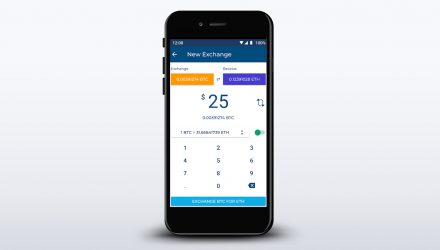
Straight to one of the most interesting Blockchain wallet specific features – its built-in exchange. It isn’t available for all its users but just for some of the regions, supported by the project. There are more than 230 countries offering this option but if you can’t find yours in the list, send feedback to the supporting center. If you’re lucky to be part of them, you can explore the advantages of the integrated exchange by simply navigating to the dedicated tab on the left-side menu. Of course, due to the 2FA, you’ll be requested to verify your identity before you proceed using it. All the four supported coins are accessible for exchange actions in the platform. The crypto-to-crypto exchange platform of the Blockchain wallet requests you to type in the desired amount and hit the Exchange button. A pop-up window will appear with confirmation of the requested action and if everything’s correct, you should simply click the Complete Order option to finalize the process. You can have an overview of all your orders in the History tab of the interface.
If we stop by to the built-in exchange’s fees, the usual process might be observed. Since there are two transactions to exchange a cryptocurrency – one to send yours and another one to receive the switched one, you’re supposed to pay for the outcoming payment and receive the swapped for free. Fees are considered proper chosen, depending on the currency’s current price.
Is Blockchain Wallet Safe?
Security
Creating a password has always been a standard encryption measure, but when it comes to the Blockchain wallet, you should know that you’re not able to reset it if you ever lose or forget it. That’s the reason why you should keep it safe and secure. Ultimately, if you would like to restore your wallet, this happens via backup phrase, which is the second thing to note and hide well. I always recommend making several copies of both the phrases and put them in different places.
What’s more when speaking of security is the two-factor authentication. This feature will additionally protect your coins by requesting a specific piece of information every time when you log into your wallet or perform an action with it.
Two-Factor Authentication
The Two-Factor Authentication feature requires you type in specific information when you log into your wallet or request to make a change. It might be an SMS, a PIN code or a text to fill, depending on your choice
Encryption
Password encryption is one of the basic processes to implement in each wallet. What’s different here is the availability of two separate phrases – a password one and a backup one to restore your wallet with. Anyway, keep them both safe and secure
Privacy and Anonymity
The Blockchain wallet possesses one of the most attractive anonymity features for the majority of crypto users – its hierarchical deterministic nature. This allows you to use a different public key for each of your transactions, which basically make you balance untraceable. If you’re privacy orientated, you might also like the Tor browser option. It prevents your IP address and the ability to get hacked dramatically decrease.
Tor Browser Compatibility
You might protect your privacy but operating with the TOR browser. It prevents your IP address from being accessed by potential hackers.
Hierarchical Deterministic
When it comes to the anonymity of your balance, you can make it a bit hard to trace by generating different public addresses for each transaction you receive.
Is Blockchain the Wallet For You?
Download HereTransaction Fees
If you would like to know how much fees you’re going to pay for a certain transaction, then go to the particular coin you’ll operate with and check its details. Once again, only the Ethereum taxes are fixed, the other three coins are influenced by a dynamic pricing model, which calculates the fee, depending on the network conditions at the moment and the size of your payment.
When it comes to choosing, you might either set a Priority or a Regular fee. If you decide on the first option, then your transaction will be added to the blockchain in the next one hour. If you keep the second possibility, you should be a bit more patient.
Conclusion
Finally, since you know all that it comes to security and privacy from this review of the Blockchain wallet, you can decide if it’s fitting your needs. The extended safety precautions such as 2FA and Encryption in tandem with the Anonymity opportunities of an HD generator and Tor browser usage are more than a tasty bite.
Well, if you’re still not sure about it and the perfectly matching you wallet should propose an all-the-time adequate available support, then you might consider thinking of another option. I would like to propose you the alternative, called Green Address Wallet.
02.Blockchain Wallet Guide: How to Setup and Use
Even considered easy to use and operate with, I would like to walk you through how to use the Blockchain wallet and how to set it up before that. This section aims to provide you everything you with need to know about it and how to deal with the possible issues.
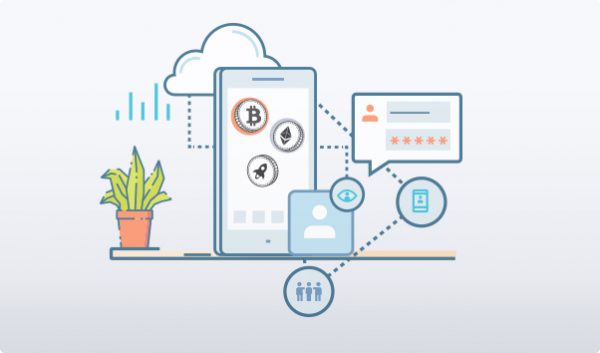
How to Install
As a web wallet, there are no specific installation steps to follow but simply register and log in to the platform. When it comes to the mobile versions, I would like to split the process into several stages for the purpose of making it completely clear. Choose one of the guides below, depending on your phone’s operating system.
Choose Operating System
- Search for the Blockchain wallet in the Google Play Store
- Click the Install button
- Create yourself an account
- Type in Blockchain wallet in the Apple App Store
- Click the Get button
- Sign in an account
Interface Overview
Considered an intuitive and easy to understand platform, the Blockchain wallet provides a simple GUI design to fit even less technically orientated users. You can see your current balance and recently placed transactions on the home page. When Sending or Receiving you can use both digital string or a QR-code.
Create an Address
When you go to the “Addresses” section, you’ll be able to organize your wallet. Choose from creating multiple sub-wallets to distinguish your funds or generate new ones. You can manage it all using this tab. The creation of a new address also happens here. Just click on the “+” button.
If you ever decide to import an address from another wallet, here’s the place to do so. Make sure you completely understand what you’re doing to avoid any mistakes.
Send and Receive Assets
For the purpose of sending some coins you’re supposed to simply enter the receiver’s address and type in the desired amount to transfer. The fee will automatically appear and when you submit the request a pop-up confirmation window will summary your data. Approve it and it’s all done.
Same with receiving coins, generate yourself an address by clicking on the coin you would like to receive and share it with the sender in the form of a string or a QR-code. Make a note that your Ethereum address will remain the same.
Hint: Always double check the recipient’s address before you confirm a transaction. If there’s a mistake in it, your funds will go to the nowhere and he’ll never receive them.
Backup and Restore
It happens sometimes to lose or forget your password. Fortunately, the Blockchain wallet offers both Backup and Restore options to save the day. Check them out:
Backup
Install and deposit your crypto
Here’s the moment to use the backup phrase from the initial creation of your wallet. The 12-words string will allow you to activate your previous data if you simply click on the Backup Phrase button in the Security Center and select the dedicated option.
Create a strong password and save it
To create a strong password, it must contain at least 16 characters. Use numbers, letters and special symbols. Most important – never use the same one twice.
Specific Functions
Here, I would like to show you something specific when it comes to the mobile edition of the Blockchain wallet. It’s completely understandable to prove millions of downloads of this version because of the interesting pairing code feature in it. This is actually a QR-code to synch your web and mobile wallet. All you need to do is to check if you’re supporting the latest version of the wallet on both your devices.
When you initially run the mobile app, follow the 3 stages and then log into your computer and enter your account. When you click the Show Pairing Code button, the system will display it as a QR-code to scan with your smartphone. This is something to highly secure your funds and you should definitely keep this code away from other people’s eyes.
Possible Issues and How to Avoid Them
Most commonly experienced issue? It’s the confirmation email. If you’re missing your authorization email after more than five minutes, then check your spam folder. You can even add the Blockchain wallet in your contact to prevent their emails from being filtered out. Not there? Call your email provider to make sure they haven’t block the Blockchain domain.
03.FAQ
-
If someone steal my phone, are my coins safe?
If you have set the PIN protection, you have enough time to go and change your setting via the web version.
-
How to proceed if I lose my PIN-code?
If you mistake it 4 times, then the app will request you for your password. If you don’t have this one too, then use your Backup phrase to access.
04.About Blockchain Wallet
Founded in 2011, Blockchain has become one of the most preferred crypto platforms nowadays. Used by more than 15 million users and working on 160k transactions per day is a witness of the talented team, developed such an attractive software. Available in both web and mobile versions, the Blockchain wallet is a leading choice of the crypto users.
Blockchain Wallet on Social Media
Social media always influenced everything, surrounding us. It keeps you updated and tuned for what’s coming and you’re able to stay informed for what interests you most. Follow the Blockchain wallet account to get the latest news when it comes to your wallet and its enhancements.
